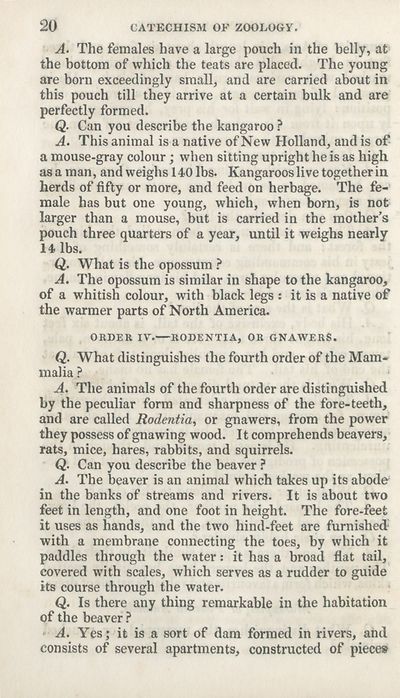Download files
Complete book:
Individual page:
Thumbnail gallery: Grid view | List view

20 CATECHISM OF ZOOLOGY.
A. The females have a large pouch in the belly, at
the bottom of which the teats are placed. The young
are born exceedingly small, and are carried about in
this pouch till they arrive at a certain bulk and are
perfectly formed.
Q- Can you describe the kangaroo ?
A. This animal is a native of New Holland, and is of
a mouse-gray colour ; when sitting upright he is as high
as a man, and weighs HO lbs. Kangaroos live togetherin
herds of fifty or more, and feed on herbage. The fe¬
male has but one young, which, when born, is not
larger than a mouse, but is carried in the mother’s
pouch three quarters of a year, until it weighs nearly
14 lbs.
Q. What is the opossum ?
A. The opossum is similar in shape to the kangaroo,
of a whitish colour, with black legs : it is a native of
the warmer parts of North America.
ORDER IV. RODENTIA, OR GNAWERS.
Q. What distinguishes the fourth order of the Mam¬
malia ?
A. The animals of the fourth order are distinguished
by the peculiar form and sharpness of the fore-teeth,
and are called Rodentia, or gnawers, from the power
they possess of gnawing wood. 11 comprehends beavers,
rats, mice, hares, rabbits, and squirrels.
Q. Can you describe the beaver ?
A. The beaver is an animal which takes up its abode
in the banks of streams and rivers. It is about two
feet in length, and one foot in height. The fore-feet
it uses as hands, and the two hind-feet are furnished
with a membrane connecting the toes, by which it
paddles through the water: it has a broad flat tail,
covered with scales, which serves as a rudder to guide
its course through the water.
Q. Is there any thing remarkable in the habitation
of the beaver ?
A. Yes; it is a sort of dam formed in rivers, and
consists of several apartments, constructed of piece#
A. The females have a large pouch in the belly, at
the bottom of which the teats are placed. The young
are born exceedingly small, and are carried about in
this pouch till they arrive at a certain bulk and are
perfectly formed.
Q- Can you describe the kangaroo ?
A. This animal is a native of New Holland, and is of
a mouse-gray colour ; when sitting upright he is as high
as a man, and weighs HO lbs. Kangaroos live togetherin
herds of fifty or more, and feed on herbage. The fe¬
male has but one young, which, when born, is not
larger than a mouse, but is carried in the mother’s
pouch three quarters of a year, until it weighs nearly
14 lbs.
Q. What is the opossum ?
A. The opossum is similar in shape to the kangaroo,
of a whitish colour, with black legs : it is a native of
the warmer parts of North America.
ORDER IV. RODENTIA, OR GNAWERS.
Q. What distinguishes the fourth order of the Mam¬
malia ?
A. The animals of the fourth order are distinguished
by the peculiar form and sharpness of the fore-teeth,
and are called Rodentia, or gnawers, from the power
they possess of gnawing wood. 11 comprehends beavers,
rats, mice, hares, rabbits, and squirrels.
Q. Can you describe the beaver ?
A. The beaver is an animal which takes up its abode
in the banks of streams and rivers. It is about two
feet in length, and one foot in height. The fore-feet
it uses as hands, and the two hind-feet are furnished
with a membrane connecting the toes, by which it
paddles through the water: it has a broad flat tail,
covered with scales, which serves as a rudder to guide
its course through the water.
Q. Is there any thing remarkable in the habitation
of the beaver ?
A. Yes; it is a sort of dam formed in rivers, and
consists of several apartments, constructed of piece#
Set display mode to:
![]() Universal Viewer |
Universal Viewer | ![]() Mirador |
Large image | Transcription
Mirador |
Large image | Transcription
| Antiquarian books of Scotland > Curiosities & wonders > Catechism of zoology, or, Natural history of the animal kingdom > (26) |
|---|
| Permanent URL | https://digital.nls.uk/113571166 |
|---|
| Description | Thousands of printed books from the Antiquarian Books of Scotland collection which dates from 1641 to the 1980s. The collection consists of 14,800 books which were published in Scotland or have a Scottish connection, e.g. through the author, printer or owner. Subjects covered include sport, education, diseases, adventure, occupations, Jacobites, politics and religion. Among the 29 languages represented are English, Gaelic, Italian, French, Russian and Swedish. |
|---|

